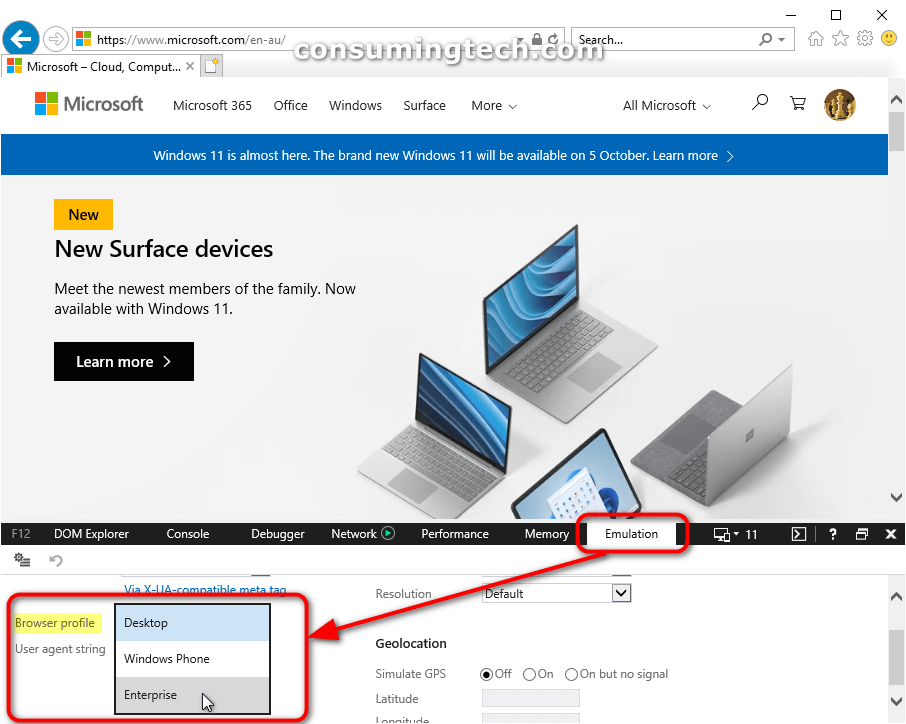Last Updated on September 27, 2021 by Mathew Diekhake
The following tutorial demonstrates how to turn on or off Enterprise Mode for websites when using the Internet Explorer 11 browser. Note that this tutorial is for turning Enterprise Mode on and off rather than enabling and disabling it. If you would like to enable and disable Enterprise Mode, see this tutorial instead: How to Enable/Disable Enterprise Mode for Internet Explorer 11 [Tutorial].
Although Microsoft had developed a newer web browser, Internet Explorer was still available to use in Windows 10 when users made the upgrade; and in fact, IE 11 is still available to be opened today if you were to search for it from the search box in the taskbar.
IE being available is important for some people because many had gotten to know it over the years and still enjoyed using it. At some point those people will have to make the switch over to a newer browser such as Microsoft Edge however because the development of IE 11 has stopped, i.e., the IE browser has been discontinued. This will eventually lead to incompatibility problems as you always need to update a browser so that it works with the newer software that is attempting to be shown on it. There’s also the chance it will become a security risk as well.
But for the time being, there’s nothing wrong with using IE 11. Due to its popularity, it’s not uncommon for Windows users to open it up and check it out or use it as a second or third browser for some tasks they wish to be separated from their main daily browser. And there are some advantages to IE 11: websites tend to appear closer up when viewing from laptops than some alternatives, no toolbars are taking up unnecessary screen real estate, and it has tabs beneath the address bar which is unique to modern browsers for no particular reason.
How to Turn On/Off Enterprise Mode for Websites in Internet Explorer 11
You can switch between Enterprise Mode and Desktop Mode directly from the Emulation tab in Internet Explorer 11. However, you will not find this feature from the typical locations, such as the Internet Options dialog box. Instead, you need to open the Developer Tools section of IE. Here is how you can do it:
1. Open the Internet Explorer browser and then press the F12 key to open the Developer Tools section across the bottom of the browser window.
2. With Developer Tools open, click on the Emulation tab and then click on the box next to where it says Browser profile and select either Enterprise Mode or Desktop Mode.
Note: When you select Enterprise Mode from the drop-down menu, you have turned on Enterprise Mode. Conversely, when you select Desktop Mode, which is the standard mode the browser comes in, you have turned off Enterprise Mode.
In conclusion, that is how to choose between Desktop Mode and Enterprise Mode when using the Internet Explorer 11 browser. As mentioned, whenever you have selected for it to be in Desktop Mode, it means that Enterprise Mode is off. As for Enterprise Mode being on, simply select it. You can always press F12 again and check whether or not Enterprise Mode is still selected if you aren’t sure, but once you watch the browser reload, which occurs as soon as you have selected Enterprise from the menu, it will be running in Enterprise Mode.
(This article was last updated on September 27, 2021.)
Related Tutorials
- How to Reset Internet Explorer 11 Settings and Data to Default Condition in Windows 10 [Tutorial]
- How to Add/Remove ‘Open Microsoft Edge Tab’ in Internet Explorer 11 [Tutorial]
- How to Open Website in Microsoft Edge with Internet Explorer [Tutorial]
- How to Disable/Enable Internet Explorer in Windows 10 [Tutorial]
- How to Install/Uninstall Internet Explorer 11 [Tutorial]
- How to Add/Remove ‘Open Microsoft Edge’ Tab in Internet Explorer 11 [Tutorial]
- How to Turn On/Off Play Sounds in Webpages in Internet Explorer 11 [Tutorial]
- How to Hide/Show Search Box in Internet Explorer 11 [Tutorial]
- How to Enable/Disable Enterprise Mode for Internet Explorer 11 [Tutorial]
- How to Add/Remove Internet Explorer 11 Power Options in Windows 10 [Tutorial]

